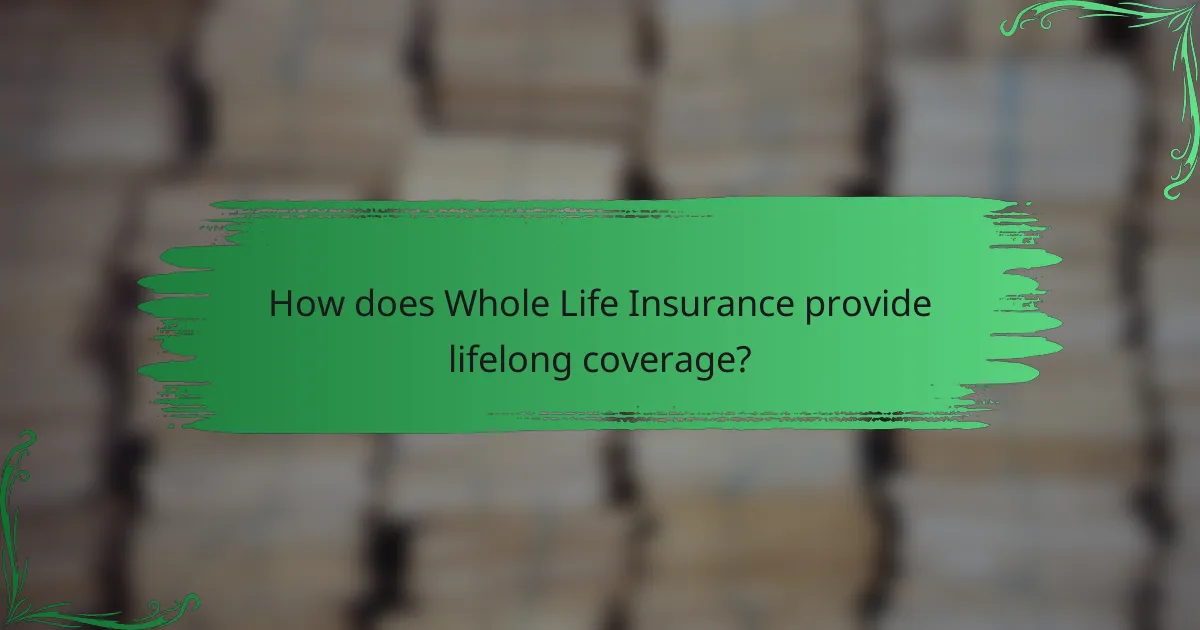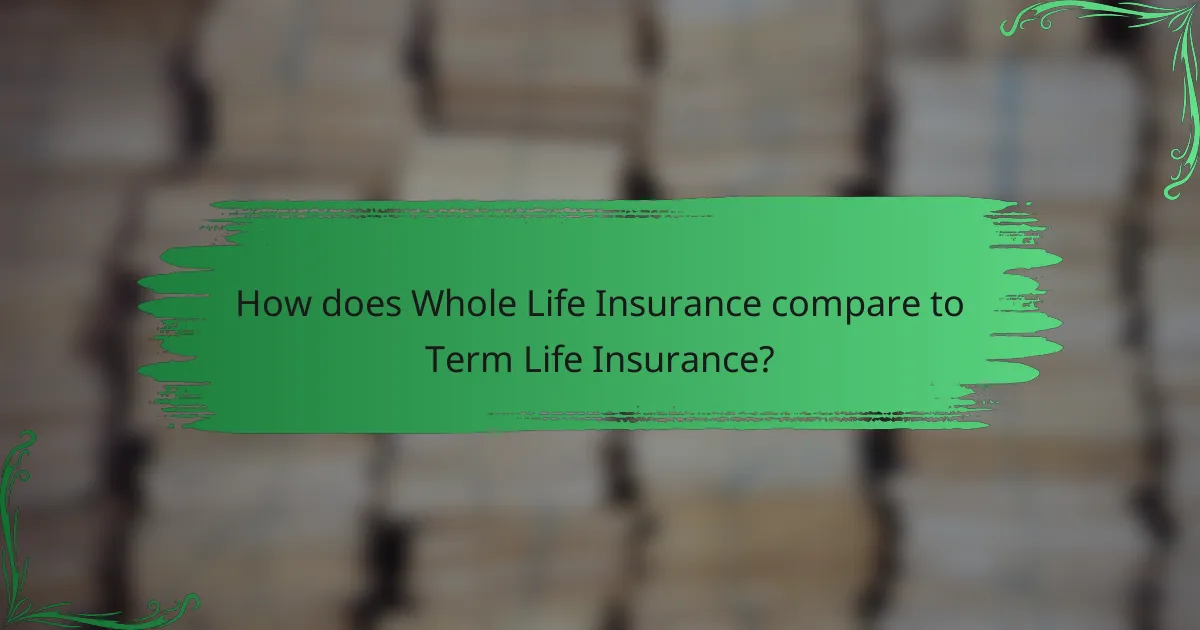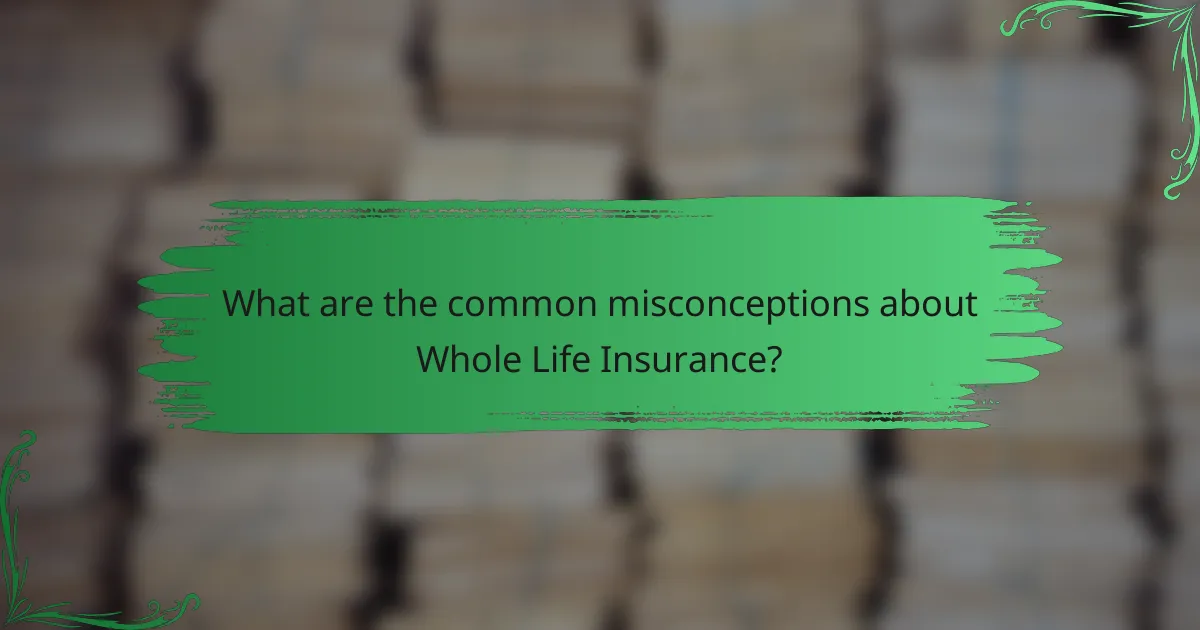Whole life insurance is a permanent insurance solution that guarantees lifelong coverage while also building cash value over time. This dual-purpose policy not only provides a death benefit to beneficiaries but also allows policyholders to access accumulated cash value, making it an effective tool for establishing a financial legacy and planning for future needs.

What is Whole Life Insurance?
Whole life insurance is a type of permanent life insurance that provides lifelong coverage and includes a cash value component. This policy not only pays a death benefit to beneficiaries but also accumulates cash value over time, which can be borrowed against or withdrawn if needed.
Definition of Whole Life Insurance
Whole life insurance is designed to offer coverage for the policyholder’s entire life, as long as premiums are paid. Unlike term life insurance, which expires after a set period, whole life policies remain in force indefinitely, ensuring a financial legacy for loved ones.
The cash value of a whole life policy grows at a guaranteed rate, providing a savings element that can be utilized during the policyholder’s lifetime. This makes whole life insurance a unique blend of protection and investment.
Key Features of Whole Life Insurance
Whole life insurance comes with several key features that distinguish it from other types of policies. These include a guaranteed death benefit, fixed premiums, and a cash value that grows over time. The cash value can be accessed through loans or withdrawals, providing financial flexibility.
Premiums for whole life insurance are typically higher than for term policies, reflecting the lifelong coverage and cash value growth. It’s essential to consider your long-term financial goals and whether the higher cost aligns with your budget and needs.
- Guaranteed Death Benefit: Provides financial protection for beneficiaries.
- Cash Value Accumulation: Grows at a guaranteed rate, offering a savings component.
- Fixed Premiums: Ensures predictable costs throughout the policyholder’s life.

How does Whole Life Insurance provide lifelong coverage?
Whole life insurance offers lifelong coverage by ensuring that the policy remains in force as long as premiums are paid. This type of insurance not only provides a death benefit but also accumulates cash value over time, making it a dual-purpose financial tool.
Guaranteed Coverage Until Death
Whole life insurance guarantees coverage for the insured’s entire life, meaning beneficiaries will receive a death benefit regardless of when the policyholder passes away, as long as premiums are maintained. This feature provides peace of mind, knowing that loved ones will have financial support when needed most.
Policies typically specify a fixed death benefit amount, which can be a crucial factor in estate planning. For example, a policyholder may choose a death benefit that covers outstanding debts, funeral expenses, or provides an inheritance for heirs.
Premium Payment Structure
The premium payment structure for whole life insurance is generally level, meaning that the amount remains constant throughout the life of the policy. This predictability allows policyholders to budget effectively, as they will not face increasing premiums as they age or if their health declines.
Premiums can be paid annually, semi-annually, or monthly, depending on the policy terms. It’s essential to consider the long-term financial commitment, as failing to pay premiums can lead to policy lapse or reduced benefits. Some policies also offer flexible payment options that can be beneficial for those with varying cash flow.

What are the benefits of Whole Life Insurance for financial legacy?
Whole life insurance provides lifelong coverage and a guaranteed death benefit, making it a valuable tool for establishing a financial legacy. It also accumulates cash value over time, which can be accessed during the policyholder’s lifetime, enhancing its appeal as a long-term financial strategy.
Death Benefit for Beneficiaries
The death benefit from a whole life insurance policy is paid out tax-free to beneficiaries, providing them with immediate financial support upon the policyholder’s passing. This benefit can help cover funeral expenses, pay off debts, or serve as an inheritance, ensuring that loved ones are financially secure.
When selecting a policy, consider the amount of coverage needed based on your family’s financial obligations and future goals. A typical range for death benefits can vary from tens of thousands to several million dollars, depending on individual circumstances.
Estate Planning Advantages
Whole life insurance can play a significant role in estate planning by providing liquidity to cover estate taxes and other expenses, preventing the need to liquidate assets. This ensures that heirs receive the intended inheritance without financial strain.
Additionally, the cash value of whole life insurance can be utilized as a financial resource during retirement or for other investments. It’s essential to consult with a financial advisor to integrate whole life insurance effectively into your overall estate plan, ensuring it aligns with your financial legacy goals.

How does cash value growth work in Whole Life Insurance?
Cash value growth in whole life insurance occurs as part of the policy’s guaranteed benefits, allowing policyholders to accumulate savings over time. A portion of each premium payment contributes to this cash value, which grows at a predetermined rate, providing both a financial safety net and potential borrowing options.
Accumulation of Cash Value
The accumulation of cash value in whole life insurance is typically slow but steady, often growing at a fixed interest rate. This growth can be influenced by factors such as the insurer’s performance and dividend payments, which may enhance the cash value. Generally, cash value starts to build after a few years of premium payments, with many policies reaching significant amounts after a decade or more.
For example, if you pay annual premiums of around $3,000, you might see your cash value grow to several thousand dollars within the first ten years. This cash value can be accessed through loans or withdrawals, providing liquidity when needed.
Tax Advantages of Cash Value
One of the key benefits of cash value in whole life insurance is its tax-deferred growth. This means that you do not pay taxes on the accumulated cash value as it grows, allowing for more substantial savings over time. Additionally, when you withdraw funds or take out a loan against the cash value, the amounts may not be subject to income tax, provided the policy remains in force.
However, it’s essential to be cautious with withdrawals and loans, as they can reduce the death benefit and may incur taxes if the policy lapses. Always consult with a financial advisor to understand the implications of accessing your cash value and to ensure you are making the most of these tax advantages.

What factors should you consider when choosing Whole Life Insurance?
When selecting Whole Life Insurance, consider the insurer’s reputation, the policy’s terms and conditions, and how these factors align with your financial goals. Understanding these elements can help you make an informed decision that ensures lifelong coverage and financial legacy.
Insurance Provider Reputation
The reputation of the insurance provider is crucial when choosing Whole Life Insurance. Look for companies with strong financial ratings from agencies like A.M. Best or Standard & Poor’s, as these ratings indicate the insurer’s ability to meet its long-term obligations.
Research customer reviews and claims satisfaction ratings to gauge the provider’s service quality. A reputable company is more likely to handle claims efficiently and provide reliable support throughout the policy’s duration.
Policy Terms and Conditions
Carefully examine the policy terms and conditions of Whole Life Insurance. Key aspects include premium amounts, payment frequency, and the policy’s cash value growth potential. Ensure you understand how the cash value accumulates and any fees associated with accessing it.
Compare different policies to find the best fit for your financial situation. Look for features like dividend payments, which can enhance cash value, and consider any exclusions or limitations that may affect your coverage.

How does Whole Life Insurance compare to Term Life Insurance?
Whole life insurance provides lifelong coverage and a cash value component, while term life insurance offers coverage for a specified period, typically 10 to 30 years. The choice between them hinges on your long-term financial goals and budget considerations.
Coverage Duration Differences
Whole life insurance is designed to last your entire life, ensuring that a death benefit is paid out regardless of when you pass away. In contrast, term life insurance only pays a benefit if the insured dies within the specified term, which can lead to no payout if the term expires without a claim.
This distinction is crucial for those looking to leave a financial legacy or cover lifelong expenses, such as funeral costs or estate taxes. If you anticipate needing coverage beyond a certain age, whole life may be the better option.
Cost Comparison
Whole life insurance typically has higher premiums than term life insurance due to its lifelong coverage and cash value accumulation. Premiums can range from several hundred to thousands of dollars annually, depending on factors like age, health, and coverage amount.
Term life insurance, on the other hand, is generally more affordable, with premiums often being a fraction of whole life costs for the same coverage amount. However, it’s essential to consider that once the term ends, you may need to purchase a new policy at a higher rate or lose coverage altogether.

What are the common misconceptions about Whole Life Insurance?
Many people misunderstand Whole Life Insurance, believing it to be inflexible or overly expensive. In reality, it offers lifelong coverage, a cash value component, and can serve as a financial legacy for beneficiaries.
Myths vs. Facts
A prevalent myth is that Whole Life Insurance is only for the wealthy due to its higher premiums. However, while it may require a larger initial investment compared to term insurance, it provides lifelong benefits and cash value accumulation that can be advantageous for various financial situations.
Another misconception is that Whole Life policies do not allow for any flexibility. In fact, many policies offer options for adjusting premiums and death benefits, allowing policyholders to tailor their coverage to their changing needs.
Understanding Policy Complexity
Whole Life Insurance can appear complex due to its various components, including premiums, cash value, and dividends. It’s essential to understand that the cash value grows at a guaranteed rate, and dividends, if declared, can enhance this growth.
When evaluating a Whole Life policy, consider the long-term commitment it entails. The cash value typically takes several years to build significantly, so it’s crucial to assess your financial goals and whether you can maintain the policy for the long haul.

What trends are shaping the future of Whole Life Insurance?
Whole life insurance is evolving due to advancements in technology, changing consumer preferences, and a growing emphasis on financial wellness. These trends are influencing how policies are structured, marketed, and utilized for lifelong coverage and financial legacy.
Technological Innovations in Insurance
Technological innovations are transforming whole life insurance by enhancing customer experience and streamlining operations. Insurers are increasingly using artificial intelligence and big data analytics to assess risk more accurately and personalize policy offerings.
For example, online platforms allow potential policyholders to compare quotes and customize coverage options easily. Mobile apps are also emerging, enabling policyholders to manage their accounts, track cash value growth, and access resources on financial planning directly from their smartphones.
As these technologies advance, consumers can expect more transparency and efficiency in the purchasing process. However, it’s crucial to remain vigilant about data privacy and security when engaging with digital insurance platforms.



